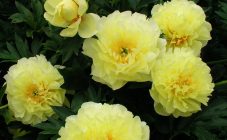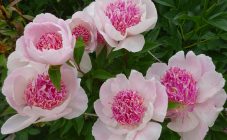Content:
Coral Charm peony gorgeous in color is wanted by many to decorate the garden. The unique shade of petals at the beginning of blooming, frost resistance and picturesqueness of the entire upright bush are valuable qualities of the variety.
Peony Coral Charm: description
The first successful interspecific hybrid of a peony with coral-colored petals was bred by US breeder Samuel E. Wissing in 1964. The flower really captivates and lives up to its name. The hybrid has received many awards at flower shows around the world.
An upright, sturdy bush of strong stems grows up to 90-120 cm tall. On average, the peduncles rise to 95 cm. Strong stems do not bend under the weight of the flower, reddish at the base, like leaf cuttings. Leaves of medium size are few, dark green, glossy above, narrowed. The peony bush is decorative throughout the warm season. Several large buds are formed on the peduncle, which bloom in the mid-early period. Gardeners noticed that from the coral series, this hybrid blooms later than its congeners. The peony blooms for a long time and profusely, it spreads a delicate and pleasant aroma.
The flowers of the grassy peony Coral Charm are large, 17-18 cm in diameter. The structure is semi-double, cupped, with a dense center of light yellow, later reddened stamens, with 7-8 rows of petals. The wide peony petals of this hybrid of a delicate coral shade. The tone of the petals changes with the duration of flowering. When the bud opens, it is a rich, warm salmon pink with orange notes. In full bloom, the petals have a light, almost white border, which creates the effect of a flower glowing from the inside, especially at dusk or in cloudy weather. Then the petals lose their intense color, become paler, acquiring shades of baked milk. Usually, the whole palette of its inherent color is collected on a peony bush of this variety, which creates an enchanting picture.
Growing
The Coral Charm peony is more often grown by hobbyists by separating the rhizome.
Landing
When choosing a place for a coral-colored peony, it should be borne in mind that in the bright sun, the petals will quickly lose their intense color and turn pale. At the same time, with a lot of shading, the stems will stretch, weaken and may fall.
Requirements for planting a peony Coral Charm:
- the optimal placement of a peony of this variety is such that a light partial shade falls on the bush at noon;
- the site should not be low-lying, close to the surface (above 1 m) groundwater can lead to rotting of the roots;
- This hybrid loves alkaline soils with a pH of 7.5;
- heavy soils are diluted in a spacious pit with sand;
- enough nutrients are placed in the planting hole, including organic matter and mineral fertilizers.
On a site with unsuitable soils, a spacious planting hole is dug to provide a high-quality substrate for 8-10 years, up to 80 cm deep, 60 x 70 cm in diameter.On light loams, 60 x 60 x 60 cm are sufficient. Drainage is laid down if necessary, then fertile substrate with fertilizers: 100-150 g of superphosphate; 300 g bone meal; 150 g of potassium sulfate or 1 liter can of wood ash.
Planting algorithm for a peony hybrid:
- if the substrate has sat down during the preparatory time, add garden soil in such a way that the buds that are on top of the rhizome of the peony are deepened only 3-5 cm from the soil surface;
- on heavy soils, deepen by 3 cm; on lighter soils, peony buds can be placed 5-6 cm below ground level;
- the rhizome is sprinkled with ordinary soil, which is well compacted;
- 5-9 liters of water are poured onto the peony seedling;
- the hole is mulched.
Care
Near the bush, the soil is regularly loosened, especially after watering, weeds are weeded. The care of peonies includes weekly watering, which is important in dry spring periods, when the bushes form flowers. For one adult plant, 25-35 liters of water is enough. It is also watered at the beginning of August, in the phase of the formation of new buds.
The first two years after planting, the Coral Charm bushes are not fertilized, the plants have enough nutrients from the hole. Then they are fed with complex flower mineral fertilizers three times: in early spring, during bud setting and 15 days after flowering. Wood ash is also used, which is poured in early spring under a bush in a volume of 0.5 liters. In July, peonies are added with solutions of mullein in a ratio of 1: 5 or bird droppings diluted 1:15. At the beginning of autumn, feeding with superphosphate is appropriate, 30 g of granules are dissolved in 10 liters of water.
Reproduction
The easiest and most affordable way for most peony lovers to breed the Coral Charm hybrid is to divide the rhizomes, which is carried out in late August, early September. Bushes over 7-8 years old are dug up, washed from the ground with a jet from a hose and left to dry. The rhizomes wilt a little and separate more easily:
- they are cut into fragments, which have several buds and thick roots;
- sprinkle cuts with wood ash, dry;
- planted immediately or the next day.
Peonies begin to bloom in the second year after transplanting. In the first season, it is better to remove the buds for successful plant survival.
Preparing for winter
Beautifully flowering hybrid Coral Charm frost-resistant. The plant develops well in the climatic conditions of central Russia without additional shelter for the winter, even in case of snowless, but frosty weather, up to -30 oC. With the appearance of constant frosts, the stems are cut to 2-4 cm above the ground. In late autumn, before frosts, the seedling is mulched with peat or rotted straw, in which rodents will not start, with a layer of 10-12 cm. For adult bushes, humus, plant residues from a flower garden or vegetable garden are also used as mulch. In the spring, everything is carefully removed so that the sprouts develop freely.
Prevention of diseases and pests
Peonies are threatened by ants, spreading colonies of aphids. Bushes affected by aphids are sprayed with insecticides or folk remedies are used: soap, soda solutions. The ants themselves feed on the sweet juice of peony buds. If the colony is large, the ants spoil the flowers, which become irregular, with truncated petals. Anthills are transferred to another place if they do not want to destroy insects using poisonous traps. Bronzes, which also feed on delicate petals, are harvested by hand in the morning. Insecticides are used in the event of a mass release of beetles on blossoming buds.
The real threat to peonies is root nematode infestation. Microscopic worms are in bulges that form on the root. A diseased plant is uprooted, burned and the soil is disinfected.
Peony Coral Charm in landscape design
According to the description, the peony of this variety is a colorful pearl in the garden. The unique color of the flowers makes the bush an effective soloist in any garden arrangement. Most often, the hybrid is planted on a lawn or against the background of a plain green fence, emphasizing the special beauty of the plant. A coral hybrid also stands out in group plantings of peonies, surrounded by varieties with white flowers.
Growing a Coral Charm hybrid is a fun and easy task. A beautiful and fragrant bouquet will always be ready.
















